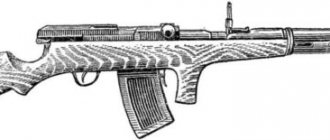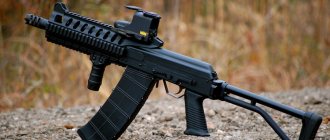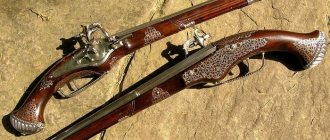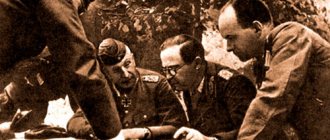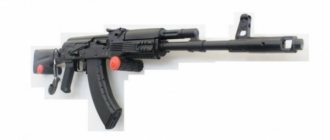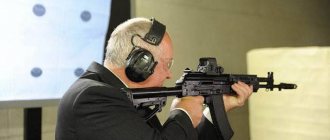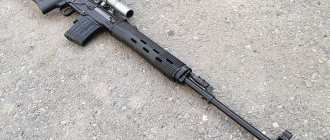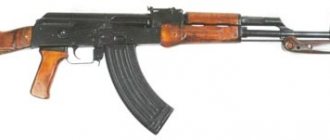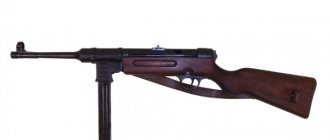The history of two iconic assault rifles, the Schmeisser and the Kalashnikov, is full of confusion and confusion. Many are convinced that “Kalashnikov” is the “Schmeiser”, and logic cannot be denied to them. And many believe that “Schmeiser” has nothing to do with its “father-creator” Hugo Schmeisser (yes, we write the name of the designer with two “s”, and the machine gun with one - it’s so established, but in German it’s the same thing and same word). Let's try to figure it all out.
Subscribe and read Express Newspaper in:
Schmeiser from Volmer
The ominous shape of the "Schmeisser" still evokes instinctive horror: the predatory "profile" of the machine gun is automatically associated with many war photographs and films. For their time, the MP-38 and its version MP-40 (punctual Germans gave numbers according to the year the products were put into production) were by far the best machine gun in the world. We can safely say that it was thanks to him that Germany was able to hold out for six years in the war against the rest of the world.
Help: Technical details:
- caliber – 9 mm;
- weight without cartridges - 4.18 kg, with cartridges - 4.85 kg (an amazingly light weapon);
- length with the butt folded down - 833 mm (also compact);
- technical rate of fire - 450 rounds per minute.
- tactical (i.e. real, taking into account the time of replacing magazines) rate of fire - 90–120 rounds per minute.
During the Great Patriotic War these machine guns were called “Schmeissers”. But, oddly enough, the remarkable engineer Hugo Schmeisser, a member of the NSDAP since 1933, had no direct connection with these ERMA models.
MP-38: The most common German machine gun during the war. Photo: wikimedia.org
This magnificent designer, a genius without a technical education (why did Hugo have an education if his father Louis was one of the best gunsmiths of the 19th century?), actually developed a number of submachine guns in the 1920s: of course, taking into account predecessors, and sometimes with direct borrowing. Automata are not literature: here you need to make an effectively working model, and if you need to copy other people’s nodes, you need to copy them! Hugo imbibed the desire to perfect the killing of people with his mother's milk.
But then we will have to plunge into the area of conspiracy theories.
According to the peace agreements of 1918-1922, defeated Germany did not have the right to develop innovative types of weapons. If back in the 1920s the Weimar Republic hesitated whether to hide or ban the relevant works, then in the 1930s the choice was clear: hide! In order to misinform foreign intelligence services, information was spread that a laboratory under the direction of Hugo Schmeisser was working on new German machine guns, although his last confirmed development was the MP-28/II. In fact, the following projects were carried out by completely different people - presumably under the leadership of Heinrich Vollmer .
MP-40: advanced version of the German assassin. Photo: wikimedia.org
In the Soviet Union, intelligence testimony was generally not taken very seriously: the feeling was created that our leadership was spreading intelligence networks only in order to summon their representatives to Moscow in 1938 and shoot them there. For example, the army commander, Deputy People's Commissar of Defense Grigory Kulik declared submachine guns a “bourgeois invention” - which significantly slowed down the domestic development of the corresponding weapons. Sudaev system submachine gun ), were inferior to the German ones in all major parameters.
But the “misinformation” did its job: even at the end of the war, we called all German machine guns “Schmeissers,” and the Kremlin personally considered Hugo Schmeisser to be perhaps the most valuable war trophy.
Who invented the Kalashnikov?
Interesting story! Hugo Schmeisser actually copied his first machine gun, the MP-18, from the Russian Fedorov submachine gun .
Fedorov assault rifle. Photo: wikimedia.org
And when, at the end of his life, after the war, the aged Schmeisser found himself in Soviet captivity, he was sent to the city of Izhevsk, where at that time the very young Mikhail Kalashnikov . Based on this fact, many conclude that in fact the famous AK-47, or at least its predecessor AK-46, was developed by a German designer. It is clear that in those years it was impossible to mention this, so, they say, they found a worthy Russian candidate - a hard-working 25-year-old boy. This also explains the lack of state awards for Kalashnikov’s weapons activities in the early stages of his career; for comparison, chess player Alexander Kotov , who took part in the development of a modification of an already existing 120 mm mortar, immediately received the Order of Lenin for this.
AK-47, classic look. Photo: wikimedia.org
We don’t pretend to be judges, but technologically the AK-47 has almost nothing in common with the MP-40 - although both designs are masterpieces of their generation. But is it really that important now? Brothers, don't shoot at each other...
Drozdov Pavel
assault rifle Kalashnikov military correspondent Interesting story
New in blogs
Young designer Mikhail Kalashnikov
Friends! Warm greetings! All liberals know that Kalashnikov did not invent any great assault rifle. Everything was brazenly stolen from the brilliant German Hugo Schmeisser. Even on the monument to the Soviet designer, idiots placed drawings of a Schmeisser assault rifle instead of an AK. I had to cut it down with a grinder.
Is it really? Who created the best machine gun of the twentieth century? Is it true that the real Misha Kalashnikov burned down in a tank, and his place was taken by a fake NKVD officer? Let's try to figure it out.
Dummy constructor.
In 2002, a certain weapons designer D. Shiryaev reported that no Kalashnikov participated in the competition for the development of an assault rifle chambered for an intermediate cartridge of the three-line caliber. And in general, even if I participated, there was no way I could win.
How can it be, on the one hand, there are venerable, honored designers. On the other hand, he’s a simple sergeant, even without a higher education. A self-taught inventor who defeats learned authorities? Unthinkable!
According to Shiryaev, Kalashnikov had nothing to do with the machine gun. He was simply included in the documents so as not to admit to the theft of Schmeiser's foreign patents. Well, we will return to Herr Hugo later.
The assault rifle is not a Kalashnikov, but a Bulkin!
Indeed, a number of design solutions for the Kalashnikov and Bulkin assault rifles are similar. Designer Tkachev points to this. In addition, the initial AK-46 prototype is very different from the AK-47 that was eventually adopted.
There is nothing surprising here - standard practice for weapons competitions. Samples of Kalashnikov, Dementiev and yes, that same Bulkin reached the stage of range shooting.
Moreover, at each stage of the competition, the commission selected the best design solutions for each unit. And she instructed the designers to modify their machines according to the best solutions.
As a result, by the final tests all three machines had become much more advanced. And much more similar to each other. Absolutely the same story happened at one time with the legendary three-line Mosin rifle.
And in general, this is not a machine gun, but a carbine!
There is a version that the AK was completely developed by the famous weapons designer Sergei Simonov. The designer is truly famous - he was the one who created one of the most popular carbines in the Soviet army and an excellent anti-tank rifle.
The version for anti-Sovietists is obvious. Simonov was close friends with the disgraced Tukhachevsky. When the marshal-conspirator was shot in 1937, Simonov also fell into disgrace.
And the new machine gun he created from a carbine (which in itself is nonsense) had to be given to the state. So the development of Simonov was attributed to the unknown sergeant Kalashnikov. And Simonov himself sat and was afraid to make a sound, so as not to be shot.
Everything would be fine, only Simonov, much later than the execution of Tukhachevsky, received the Stalin Prize twice. In 1942 for his anti-tank rifle. In 1949 for the SKS carbine.
In addition, after the war, the designer will be awarded three times the highest order of the Union - the Order of Lenin. And he will receive the golden star of the Hero of Socialist Labor. Natural disgrace, repression, complete uncertainty. Well, yes.
Mr. Schmeisser's Sturmgever.
Well, we finally got to the main version of our liberals - the AK is just a pathetic copy of Herr Schmeisser’s StG-44 assault rifle.
Well, of course, Shmeiser worked before the war at the Izhevsk Design Bureau, and it was there that the brilliant drawings were stolen. True, Kalashnikov made his assault rifle not in Izhevsk, but in Kovrov, but these are such trifles.
Externally, the machines are really similar. But apart from the curved horn and barrel design, there are almost no common features. And what is common - the gas engine, the design of the bolt locking - is not the invention of either Kalashnikov or Schmeiser.
Certain design elements appeared in the Mexican Mondragon self-loading rifle of the eighties of the nineteenth century. Both designs of machine guns also contained features of early Soviet work.
For example, Schmeiser borrowed the gas engine mechanics from the Soviet ABC rifle designed by Simonov. And a special gas piston mount was used by Degtyarev on the legendary machine gun back in 1927.
We will not provide detailed comparison tables between AK and Sturmgever. They are easy to find on the Internet. They clearly show that most of the important mechanisms are solved in completely different ways. Alas, Herr Schmeiser, alas.
Actually, it's not like that. Stolen. But the Czechs.
A whole galaxy of pseudo-historians report that Kalashnikov was stolen from the Czech ZK-420 rifle of Vaclav Holek. They also find some similarities in the trigger mechanism.
True, experts go further. The fact is that Schmeiser clearly copied his mechanics from Kholek’s rifle. And Kholek, in turn, stole the idea from Simonov’s self-loading machine from the twenties.
In response to this, Mikhail Kalashnikov himself silently demonstrated the experimental designs of his carbine and submachine gun, stored in the Leningrad Historical Museum.
Kalashnikov implemented the same trigger mechanism on them already in 1942. And the ZK-420 rifle went into production after the war!
There is also a version that Kalashnikov invented the machine gun after all. Only the real Kalashnikov burned down in a tank near Bryansk. And his drawings were miraculously preserved and were handed over to his namesake. Well, here you can only take off your hat to the imagination of journalists.
How it really was.
Alas, the real story of creating the best machine gun in the world is much more boring and simpler. In 1941, the Kalashnikov tank commander really burned in battle with the Nazis.
With severe wounds and burns, he ends up in the hospital and is forced to remain idle for a long time, more than six months. In Almaty, he begins to work in the evacuated MAI and there he creates the first model of an automatic rifle.
The design is interesting, but crude. The commission of the People's Commissariat of Armaments sends the rifle for revision. But the designer does not back down.
Five years later, the heavily modified rifle turns into the familiar Kalashnikov assault rifle. It goes into production and into service with the army.
Was every part of the machine a brilliant innovation? Probably not. Kalashnikov managed to solve a purely engineering problem. And solve it brilliantly.
He took the best known principles of each mechanism and created from them an unrivaled automaton. Surprisingly durable, reliable and easy to mass produce. For this, thank you and eternal glory to the engineer “Mikhtim”, Mikhail Timofeevich Kalashnikov!
